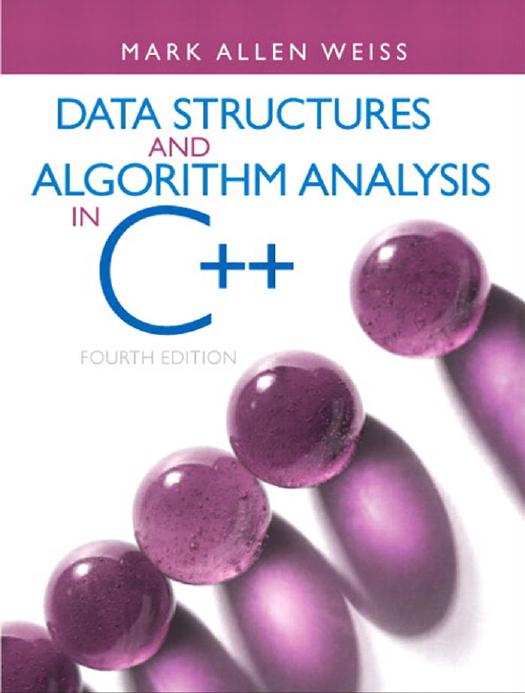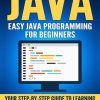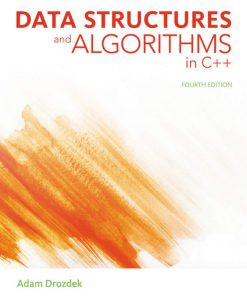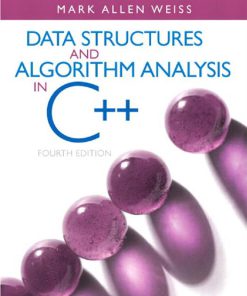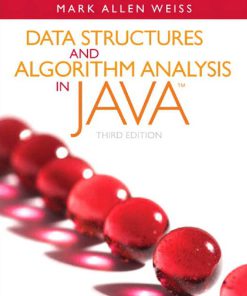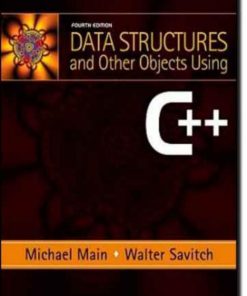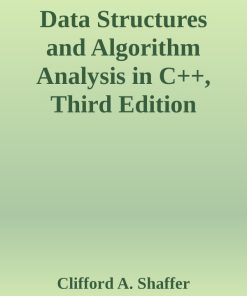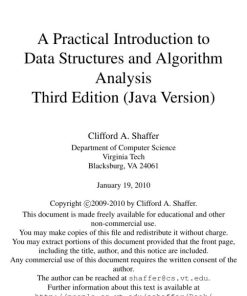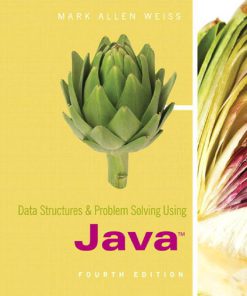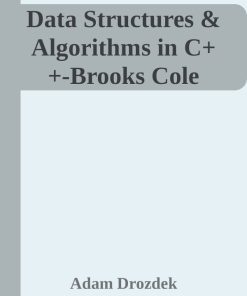Data Structures And Algorithm Analysis in C 4th Edition by Mark Weiss 013284737X 9780132847377
$50.00 Original price was: $50.00.$25.00Current price is: $25.00.
Authors:Mark A. Weiss , Series:IT & Computer [38] , Tags:Information Technology; Computer , Author sort:Weiss, Mark A. , Identifiers:Identifiers:isbn-13:9780132847377 , Languages:Languages:eng , Published:Published:Jun 2013 , Publisher:Pearson , Comments:Data Structures and Algorithm Analysis in C++ is an advanced algorithms book that bridges the gap between traditional CS2 and Algorithms Analysis courses. As the speed and power of computers increases, so does the need for effective programming and algorithm analysis. By approaching these skills in tandem, Mark Allen Weiss teaches readers to develop well-constructed, maximally efficient programs using the C++ programming language. This book explains topics from binary heaps to sorting to NP-completeness, and dedicates a full chapter to amortized analysis and advanced data structures and their implementation. Figures and examples illustrating successive stages of algorithms contribute to Weiss’ careful, rigorous and in-depth analysis of each type of algorithm.« less; « less
Data Structures And Algorithm Analysis in C 4th Edition by Mark Weiss – Ebook PDF Instant Download/Delivery. 013284737X, 9780132847377
Full download Data Structures And Algorithm Analysis in C 4th Edition after payment

Product details:
ISBN 10: 013284737X
ISBN 13: 9780132847377
Author: Mark A. Weiss
This is the eBook of the printed book and may not include any media, website access codes, or print supplements that may come packaged with the bound book. Data Structures and Algorithm Analysis in C++ is an advanced algorithms book that bridges the gap between traditional CS2 and Algorithms Analysis courses. As the speed and power of computers increases, so does the need for effective programming and algorithm analysis. By approaching these skills in tandem, Mark Allen Weiss teaches readers to develop well-constructed, maximally efficient programs using the C++ programming language. This book explains topics from binary heaps to sorting to NP-completeness, and dedicates a full chapter to amortized analysis and advanced data structures and their implementation. Figures and examples illustrating successive stages of algorithms contribute to Weiss’ careful, rigorous and in-depth analysis of each type of algorithm.
Data Structures And Algorithm Analysis in C 4th Table of contents:
Chapter 1 Programming: A General Overview
1.1 What’s This Book About?
1.2 Mathematics Review
1.2.1 Exponents
1.2.2 Logarithms
Definition 1.1
Theorem 1.1
Proof
Theorem 1.2
Proof
1.2.3 Series
1.2.4 Modular Arithmetic
1.2.5 The P Word
Proof by Induction
Theorem 1.3
Proof
Proof by Counterexample
Proof by Contradiction
1.3 A Brief Introduction to Recursion
Printing Out Numbers
Recursion and Induction
Theorem 1.4
Proof (By induction on the number of digits in n)
1.4 C++ Classes
1.4.1 Basic class Syntax
1.4.2 Extra Constructor Syntax and Accessors
Default Parameters
Initialization List
explicit Constructor
Constant Member Function
1.4.3 Separation of Interface and Implementation
Preprocessor Commands
Scope Resolution Operator
Signatures Must Match Exactly
Objects Are Declared Like Primitive Types
1.4.4 vector and string
1.5 C++ Details
1.5.1 Pointers
Declaration
Dynamic Object Creation
Garbage Collection and delete
Assignment and Comparison of Pointers
Accessing Members of an Object through a Pointer
Address-of Operator (&)
1.5.2 Lvalues, Rvalues, and References
lvalue references use #1: aliasing complicated names
lvalue references use #2: range for loops
lvalue references use #3: avoiding a copy
1.5.3 Parameter Passing
1.5.4 Return Passing
1.5.5 std::swap and std::move
1.5.6 The Big-Five: Destructor, Copy Constructor, Move Constructor, Copy Assignment operator=, Move Assignment operator=
Destructor
Copy Constructor and Move Constructor
Copy Assignment and Move Assignment (operator=)
Defaults
When the Defaults Do Not Work
1.5.7 C-style Arrays and Strings
1.6 Templates
1.6.1 Function Templates
1.6.2 Class Templates
1.6.3 Object, Comparable, and an Example
1.6.4 Function Objects
1.6.5 Separate Compilation of Class Templates
1.7 Using Matrices
1.7.1 The Data Members, Constructor, and Basic Accessors
1.7.2 operator[]
1.7.3 Big-Five
Summary
Exercises
References
Chapter 2 Algorithm Analysis
2.1 Mathematical Background
Definition 2.1
Definition 2.2
Definition 2.3
Definition 2.4
2.2 Model
2.3 What to Analyze
2.4 Running-Time Calculations
2.4.1 A Simple Example
2.4.2 General Rules
2.4.3 Solutions for the Maximum Subsequence Sum Problem
2.4.4 Logarithms in the Running Time
Binary Search
Euclid’s Algorithm
Theorem 2.1
Proof
Exponentiation
2.4.5 Limitations of Worst-Case Analysis
Summary
Exercises
References
Chapter 3 Lists, Stacks, and Queues
3.1 Abstract Data Types (ADTs)
3.2 The List ADT
3.2.1 Simple Array Implementation of Lists
3.2.2 Simple Linked Lists
3.3 vector and list in the STL
3.3.1 Iterators
Getting an Iterator
Iterator Methods
Container Operations That Require Iterators
3.3.2 Example: Using erase on a List
3.3.3 const_iterators
3.4 Implementation of vector
3.5 Implementation of list
3.6 The Stack ADT
3.6.1 Stack Model
3.6.2 Implementation of Stacks
Linked List Implementation of Stacks
Array Implementation of Stacks
3.6.3 Applications
Balancing Symbols
Postfix Expressions
Infix to Postfix Conversion
Function Calls
3.7 The Queue ADT
3.7.1 Queue Model
3.7.2 Array Implementation of Queues
3.7.3 Applications of Queues
Summary
Exercises
Chapter 4 Trees
4.1 Preliminaries
4.1.1 Implementation of Trees
4.1.2 Tree Traversals with an Application
4.2 Binary Trees
4.2.1 Implementation
4.2.2 An Example: Expression Trees
Constructing an Expression Tree
4.3 The Search Tree ADT—Binary Search Trees
4.3.1 contains
4.3.2 findMin and findMax
4.3.3 insert
4.3.4 remove
4.3.5 Destructor and Copy Constructor
4.3.6 Average-Case Analysis
4.4 AVL Trees
4.4.1 Single Rotation
4.4.2 Double Rotation
4.5 Splay Trees
4.5.1 A Simple Idea (That Does Not Work)
4.5.2 Splaying
4.6 Tree Traversals (Revisited)
4.7 B-Trees
4.8 Sets and Maps in the Standard Library
4.8.1 Sets
4.8.2 Maps
4.8.3 Implementation of set and map
4.8.4 An Example That Uses Several Maps
Summary
Exercises
References
Chapter 5 Hashing
5.1 General Idea
5.2 Hash Function
5.3 Separate Chaining
5.4 Hash Tables without Linked Lists
5.4.1 Linear Probing
5.4.2 Quadratic Probing
Theorem 5.1
Proof
5.4.3 Double Hashing
5.5 Rehashing
5.6 Hash Tables in the Standard Library
5.7 Hash Tables with Worst-Case O(1) Access
5.7.1 Perfect Hashing
Theorem 5.2
Proof
Theorem 5.3
Proof
5.7.2 Cuckoo Hashing
Cuckoo Hash Table Implementation
5.7.3 Hopscotch Hashing
5.8 Universal Hashing
Definition 5.1
Definition 5.2
Theorem 5.4
Proof
5.9 Extendible Hashing
Summary
Exercises
References
Chapter 6 Priority Queues (Heaps)
6.1 Model
6.2 Simple Implementations
6.3 Binary Heap
6.3.1 Structure Property
6.3.2 Heap-Order Property
6.3.3 Basic Heap Operations
insert
deleteMin
6.3.4 Other Heap Operations
decreaseKey
increaseKey
remove
buildHeap
Theorem 6.1
Proof
6.4 Applications of Priority Queues
6.4.1 The Selection Problem
Algorithm 6A
Algorithm 6B
6.4.2 Event Simulation
6.5 d-Heaps
6.6 Leftist Heaps
6.6.1 Leftist Heap Property
Theorem 6.2
Proof
6.6.2 Leftist Heap Operations
6.7 Skew Heaps
6.8 Binomial Queues
6.8.1 Binomial Queue Structure
6.8.2 Binomial Queue Operations
6.8.3 Implementation of Binomial Queues
6.9 Priority Queues in the Standard Library
Summary
Exercises
References
Chapter 7 Sorting
7.1 Preliminaries
7.2 Insertion Sort
7.2.1 The Algorithm
7.2.2 STL Implementation of Insertion Sort
7.2.3 Analysis of Insertion Sort
7.3 A Lower Bound for Simple Sorting Algorithms
Theorem 7.1
Proof
Theorem 7.2
Proof
7.4 Shellsort
7.4.1 Worst-Case Analysis of Shellsort
Theorem 7.3
Proof
Theorem 7.4
Proof
7.5 Heapsort
7.5.1 Analysis of Heapsort
Theorem 7.5
Proof
7.6 Mergesort
7.6.1 Analysis of Mergesort
7.7 Quicksort
7.7.1 Picking the Pivot
A Wrong Way
A Safe Maneuver
Median-of-Three Partitioning
7.7.2 Partitioning Strategy
7.7.3 Small Arrays
7.7.4 Actual Quicksort Routines
7.7.5 Analysis of Quicksort
Worst-Case Analysis
Best-Case Analysis
Average-Case Analysis
7.7.6 A Linear-Expected-Time Algorithm for Selection
7.8 A General Lower Bound for Sorting
7.8.1 Decision Trees
Proof
Proof
Theorem 7.6
Proof
Theorem 7.7
Proof
7.9 Decision-Tree Lower Bounds for Selection Problems
Proof
Theorem 7.8
Proof
Proof
Proof
Theorem 7.9
Proof
Theorem 7.10
Proof
Theorem 7.11
Proof
7.10 Adversary Lower Bounds
Theorem 7.8 (restated)
Lower Bound for Finding the Minimum and Maximum
Theorem 7.12
Proof
7.11 Linear-Time Sorts: Bucket Sort and Radix Sort
7.12 External Sorting
7.12.1 Why We Need New Algorithms
7.12.2 Model for External Sorting
7.12.3 The Simple Algorithm
7.12.4 Multiway Merge
7.12.5 Polyphase Merge
7.12.6 Replacement Selection
Summary
Exercises
References
Chapter 8 The Disjoint Sets Class
8.1 Equivalence Relations
8.2 The Dynamic Equivalence Problem
8.3 Basic Data Structure
8.4 Smart Union Algorithms
8.5 Path Compression
8.6 Worst Case for Union-by-Rank and Path Compression
8.6.1 Slowly Growing Functions
8.6.2 An Analysis by Recursive Decomposition
Proof
Proof
Partial Path Compression
A Recursive Decomposition
Proof
Proof
Proof
Theorem 8.1
Proof
Theorem 8.2
Proof
8.6.3 An O( M log*N) Bound
Theorem 8.3
Proof
8.6.4 An O( M α(M,N)) Bound
Theorem 8.4
Proof
Theorem 8.5
Proof
Theorem 8.6
Proof
8.7 An Application
Summary
Exercises
References
Chapter 9 Graph Algorithms
9.1 Definitions
9.1.1 Representation of Graphs
9.2 Topological Sort
9.3 Shortest-Path Algorithms
9.3.1 Unweighted Shortest Paths
9.3.2 Dijkstra’s Algorithm
9.3.3 Graphs with Negative Edge Costs
9.3.4 Acyclic Graphs
9.3.5 All-Pairs Shortest Path
9.3.6 Shortest Path Example
9.4 Network Flow Problems
9.4.1 A Simple Maximum-Flow Algorithm
9.5 Minimum Spanning Tree
9.5.1 Prim’s Algorithm
9.5.2 Kruskal’s Algorithm
9.6 Applications of Depth-First Search
9.6.1 Undirected Graphs
9.6.2 Biconnectivity
9.6.3 Euler Circuits
9.6.4 Directed Graphs
9.6.5 Finding Strong Components
9.7 Introduction to NP-Completeness
9.7.1 Easy vs. Hard
9.7.2 The Class NP
9.7.3 NP-Complete Problems
Summary
Exercises
References
Chapter 10 Algorithm Design Techniques
10.1 Greedy Algorithms
10.1.1 A Simple Scheduling Problem
Multiprocessor Case
Minimizing the Final Completion Time
10.1.2 Huffman Codes
Huffman’s Algorithm
10.1.3 Approximate Bin Packing
Online Algorithms
Theorem 10.1
Proof
Next Fit
Theorem 10.2
Proof
First Fit
Theorem 10.3
Proof
Best Fit
Offline Algorithms
Proof
Proof
Theorem 10.4
Proof
Theorem 10.5
Proof
10.2 Divide and Conquer
10.2.1 Running Time of Divide-and-Conquer Algorithms
Theorem 10.6
Proof
Theorem 10.7
Theorem 10.8
10.2.2 Closest-Points Problem
10.2.3 The Selection Problem
Theorem 10.9
Proof
Reducing the Average Number of Comparisons
10.2.4 Theoretical Improvements for Arithmetic Problems
Multiplying Integers
Matrix Multiplication
10.3 Dynamic Programming
10.3.1 Using a Table Instead of Recursion
10.3.2 Ordering Matrix Multiplications
10.3.3 Optimal Binary Search Tree
10.3.4 All-Pairs Shortest Path
10.4 Randomized Algorithms
10.4.1 Random-Number Generators
10.4.2 Skip Lists
10.4.3 Primality Testing
Theorem 10.10 (Fermat’s Lesser Theorem)
Proof
Theorem 10.11
Proof
10.5 Backtracking Algorithms
10.5.1 The Turnpike Reconstruction Problem
10.5.2 Games
Minimax Strategy
α–β Pruning
Summary
Exercises
References
Chapter 11 Amortized Analysis
11.1 An Unrelated Puzzle
11.2 Binomial Queues
Theorem 11.1
Proof
11.3 Skew Heaps
Definition
Theorem 11.2
Proof
11.4 Fibonacci Heaps
11.4.1 Cutting Nodes in Leftist Heaps
11.4.2 Lazy Merging for Binomial Queues
Amortized Analysis of Lazy Binomial Queues
Theorem 11.3
Proof
11.4.3 The Fibonacci Heap Operations
11.4.4 Proof of the Time Bound
Proof
Proof
Proof
Theorem 11.4
Proof
11.5 Splay Trees
Proof
Theorem 11.5
Proof
Summary
Exercises
References
Chapter 12 Advanced Data Structures and Implementation
12.1 Top-Down Splay Trees
12.2 Red-Black Trees
12.2.1 Bottom-Up Insertion
12.2.2 Top-Down Red-Black Trees
12.2.3 Top-Down Deletion
12.3 Treaps
12.4 Suffix Arrays and Suffix Trees
12.4.1 Suffix Arrays
12.4.2 Suffix Trees
12.4.3 Linear-Time Construction of Suffix Arrays and Suffix Trees
12.5 k-d Trees
12.6 Pairing Heaps
People also search for Data Structures And Algorithm Analysis in C 4th:
data structures and algorithm analysis in c ++ 4th edition
data structure and algorithm analysis
why we need to do algorithm analysis in data structure
what is the importance of data structures and algorithms
You may also like…
eBook PDF
Data Structures and Algorithm Analysis in JavaTM 3rd edition by Mark Weiss 9780133465013 0133465012
eBook PDF
A Practical Introduction to Data Structures And Algorithm Analysis 3rd Edition by Clifford Shaffer
eBook PDF
Data Structures And Problem Solving Using Java 4th Edition by Mark Weiss 0321541405 9780321541406

